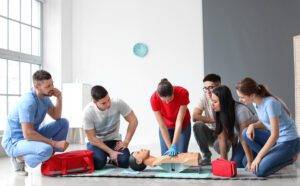Cardiopulmonary resuscitation (CPR) is a vital emergency procedure that can significantly increase the survival chances of individuals experiencing cardiac arrest.
In the United Kingdom, it is considered an essential skill for both medical professionals and the general public, as timely and effective application can save lives in critical situations. By undertaking the correct CPR training and staying updated on the current guidelines, individuals can be better prepared to handle emergencies and contribute to improved overall public health.
CPR is a combination of chest compressions and rescue breaths that work together to maintain blood flow and oxygen supply to the brain and other vital organs, when the heart unexpectedly stops functioning. The resuscitation process aims to protect essential bodily functions until further medical intervention and advanced life support can be administered. As every minute counts during cardiac arrest, bystanders who are knowledgeable in CPR can play a crucial role in enhancing a victim’s chance of survival.
Across the UK, there are numerous training programmes and resources that educate individuals on the appropriate CPR procedures, adapted to cater to specific age groups and emergency scenarios. By staying informed and practising the correct techniques, it is possible to increase the effectiveness of CPR and give those in need a fighting chance at recovery.
Understanding CPR
Basics of CPR
CPR, or Cardiopulmonary Resuscitation, is a life-saving first aid technique used to help someone experiencing a cardiac arrest. Cardiac arrest occurs when the heart suddenly stops beating, leading to a cessation of blood flow and oxygen throughout the body. When this happens, immediate action is necessary to ensure the chances of recovery for the victim.
The main objective of CPR is to maintain blood flow and oxygen supply to vital organs, particularly the brain and the heart. This technique consists of two key components: chest compressions and rescue breaths. Chest compressions involve applying pressure on the centre of the victim’s chest at a rate of 100-120 compressions per minute. Rescue breaths, on the other hand, involve providing artificial respiration by breathing into the victim’s mouth or nose.
Importance of CPR
CPR is a crucial, time-sensitive intervention for those suffering from cardiac arrest. Every minute without CPR decreases the chances of survival by 7-10%. Therefore, prompt and accurate administration of CPR can mean the difference between life and death.
Furthermore, bystander intervention plays a significant role in overall survival rates. Research shows that victims who receive CPR from a bystander have a higher likelihood of survival compared to those who only receive professional medical assistance.
Listed below are some essential features of CPR:
Timely action increases survivability
It maintains blood flow and oxygen supply
Bystander intervention can play a crucial role
CPR in the UK Healthcare System
Within the UK healthcare system, the NHS advocates for widespread knowledge and training of CPR. Various organisations such as the British Heart Foundation (BHF) and St John Ambulance offer free CPR training sessions to the public, equipping them with essential life-saving skills.
Some key aspects of CPR in the UK healthcare system include:
Public awareness and training campaigns
Emphasis on continuous skill improvement
Coordination with emergency medical services
Overall, understanding CPR and its importance in dealing with cardiac arrest is essential for preventing potential fatalities. In the UK, the NHS and other organisations promote the significance of CPR training, recognising the impact that bystander intervention can have on saving lives.
CPR Procedure
Assessing the Situation
When encountering a person who may require CPR, it is essential to first assess the situation. Check if the person is conscious by gently tapping their shoulder and asking if they are alright. If they are unresponsive, proceed with the following steps:
Check for signs of breathing by looking at their chest and listening for breaths.
Tilt their head back and lift their chin to open their airway.
If they are not breathing, or breathing irregularly, begin CPR.
Calling for Help
Before starting CPR, it is crucial to call for help. Dial 999 to request an ambulance. Inform the operator of the situation, providing details about the individual’s condition and your location. Stay on the line until you are advised to hang up.
Administering Chest Compressions
To perform chest compressions:
Position the person on their back on a firm, flat surface.
Kneel beside them and place the heel of one hand on the centre of their chest.
Place your other hand on top and interlock your fingers.
With straight arms, press down hard and fast – about 5-6 centimetres deep.
Allow the chest to rise back up before pressing down again.
Perform 30 compressions at a rate of 100 to 120 per minute.
Providing Rescue Breaths
After administering 30 chest compressions, proceed to provide two rescue breaths:
Tilt the person’s head back and lift their chin.
Pinch their nostrils closed and take a deep breath.
Cover their mouth with yours, creating a seal, and breathe into their mouth.
Watch for the chest to rise and fall, then administer a second breath.
Using an AED
If available, using an Automated External Defibrillator (AED) can greatly improve the person’s chances of survival. To use an AED:
Turn on the AED and follow the voice prompts.
Expose the person’s chest and attach the electrode pads as instructed.
Ensure everyone is clear before allowing the AED to analyse the heart rhythm.
If the AED advises a shock, ensure everyone is clear and press the shock button.
Continue CPR for two minutes before allowing the AED to reanalyse the situation.
After completing a cycle of 30 chest compressions and 2 rescue breaths, continue alternating between the two until professional help arrives or the person begins to breathe normally.
Special Considerations
CPR for Adults
When performing CPR on an adult, follow these steps:
Check for responsiveness and call for help.
Assess for breathing. If the person is not breathing or experiencing agonal gasps, start chest compressions.
Place your hands in the centre of the chest, and perform 30 chest compressions followed by two rescue breaths. Continue this cycle until help arrives or the patient regains consciousness.
Note: For Adults, the depth of chest compressions should be at least 5 cm (2 inches), and the rate should be between 100 to 120 compressions per minute.
CPR for Children and Infants
CPR procedure differs slightly for children (ages 1 to puberty) and infants (under 1 year of age) as follows:
Age Group
Compression Depth
Compression Rate
Compressions to Breaths Ratio
Fingers/Hands Placement
Children
5 cm (2 inches)
100-120/min
30:2 (1 rescuer) / 15:2 (2+ rescuers)
Heel of one or two hands
Infants
4 cm (1.5 inches)
100-120/min
30:2 (1 rescuer) / 15:2 (2+ rescuers)
Two fingers or thumbs enclosed
Remember: Check for signs of choking and act accordingly before initiating CPR in children and infants.
CPR with COVID-19 Precautions
During the COVID-19 pandemic, additional measures should be taken to reduce the risk of virus transmission when performing CPR:
Wear a mask and gloves if possible.
Place a cloth or mask over the patient’s mouth and nose before giving rescue breaths.
Use a barrier device, like a pocket mask or face shield, when giving breaths.
If you are untrained or unwilling to give rescue breaths, perform compression-only CPR by providing continuous chest compressions without rescue breaths.
Stay informed about any updated guidelines from health authorities regarding CPR during the COVID-19 pandemic.
CPR Techniques and Theory
Compression Rate and Depth
When performing CPR, it is vital to apply the correct compression rate and depth to ensure effective chest compressions. The recommended rate for compressions is 100 to 120 per minute. To achieve the correct depth, compress the victim’s chest by approximately 5 to 6 centimetres. The goal is to compress the breastbone, which helps circulate blood throughout the body.
It is essential to allow the chest to rise completely between compressions to let the heart refill with blood. Maintain a steady rhythm by counting out loud or using a metronome to guide the pace.
Recovery Position
The recovery position is a crucial step to maintain an open airway for an unconscious victim who is breathing normally but cannot maintain their own airway. To place the person in the recovery position:
Extend the arm closest to you, at a right angle to their body.
Position the other arm across the chest, with the back of their hand against the nearest cheek.
Bend the farthest leg from you at the knee, while keeping the foot flat on the ground.
Carefully roll the person towards you, onto their side by pulling on the bent knee.
Tilt the head back slightly to keep the airway open.
The recovery position assists in preventing the tongue from obstructing the airway and helps to drain any fluids.
Airway Management
Airway management is a key component of CPR, as the purpose is to ensure oxygen reaches the brain and other vital organs. To achieve this:
Place one hand on the victim’s forehead and gently tilt the head back.
Use two fingers from your other hand to lift the chin upwards.
This “head-tilt and chin-lift” manoeuvre can help remove any blockages and open the airway. Remember to check for breathing and respond accordingly. If the person is not breathing, continue with chest compressions and rescue breaths as per CPR guidelines.
First Aid Equipment
Types of AEDs
There are various types of Automated External Defibrillators (AEDs) available in the UK, each designed for different situations and users. The main types include:
Semi-automatic AEDs: These devices require the rescuer to press a button to deliver a shock if one is advised. They are suitable for trained first aiders or bystanders with some basic knowledge of CPR.
Fully-automatic AEDs: These defibrillators analyse the victim’s heart rhythm and deliver a shock automatically when needed. They are ideal for public places as they can be used by individuals with minimal or no training.
Type
Advantages
Disadvantages
Semi-automatic
Suitable for trained individuals
Require manual intervention for a shock
Fully-automatic
Ideal for use in public spaces and with no training
Less control in treatment delivery
Some AEDs offer additional features, like spoken instructions or visual prompts to guide the user through the CPR process.
Other Essential Equipment
Apart from AEDs, a range of other essential first aid equipment is useful in the administration of CPR, providing necessary support and enhancing rescue efforts:
Oxygen: Supplemental oxygen can be crucial in improving a victim’s chances of survival. When used alongside CPR, it raises the levels of oxygen in the bloodstream, increasing the likelihood of successful resuscitation.
CPR Face Shield or Pocket Mask: A face shield or pocket mask aids in providing rescue breaths to the victim while protecting the rescuer from potential infections.
CPR Feedback Device: This tool gives real-time feedback on the quality of chest compressions, keeping first aiders aligned with guidelines and ensuring more effective CPR.
First Aid Kit: A well-stocked first aid kit may contain essential items such as sterile gloves, bandages, and adhesive plasters to assist in delivering CPR and treating any accompanying injuries.
The availability and use of these first aid equipment items can significantly improve the chances of successful CPR and, ultimately, save lives.
Legal and Ethical Considerations
Duty to Act
In the UK, there is no legal obligation for a bystander to perform CPR on someone in need. However, healthcare professionals may have a duty to act depending on their role and the circumstances. This duty can be based on professional obligations or employer/employee contracts. For instance, if an Automated External Defibrillator (AED) is provided by the employer, the staff may have a responsibility to use it in case of an emergency.
Moreover, Good Samaritan laws protect individuals who voluntarily provide emergency care without expecting any compensation. So, as long as the rescuer acts in good faith and within the bounds of their training, they are protected from liability claims.
Consent and Liability
Before initiating CPR, obtaining consent is essential wherever possible. In case the person is unconscious and unable to provide consent, the law permits implied consent, assuming that the patient would agree to life-saving measures. However, if a person regains consciousness and refuses CPR, the rescuer must respect their wishes.
Concerning liability, UK law ensures protection for those who perform CPR in an emergency. As long as rescuers follow proper guidelines and act within their training, they are covered by the law from any potential accusations of negligence. Take note of the following aspects:
Always act within the scope of your knowledge and training while performing CPR.
Follow established protocols and guidelines, e.g., British Resuscitation Council guidelines, when using an AED and during CPR.
Be respectful and considerate of the patient’s dignity and privacy during an emergency.
Being mindful of the legal and ethical considerations, individuals administering CPR can confidently focus on their primary objective – helping to save lives in times of emergency.
CPR Training and Certification
CPR training and certification in the UK are essential for individuals who want to be prepared to handle emergency situations involving cardiac arrest. The training courses are designed to provide knowledge and practical skills required to perform CPR effectively. These courses cover different levels of CPR training, including Basic Life Support (BLS), Advanced Life Support (ALS), Paediatric CPR, and First-Aider responsibilities.
Basic Life Support (BLS)
Basic Life Support training focuses on providing essential knowledge and skills to handle common emergency situations. This level of training involves learning the DRSABCD action plan:
Danger
Response
Shout for help
Airway
Breathing
Compressions
Defibrillation
A BLS certification course teaches participants how to recognise and respond to life-threatening emergencies, perform chest compressions, and use an automated external defibrillator (AED).
Advanced Life Support (ALS)
Advanced Life Support training is designed for healthcare professionals and emergency responders. ALS courses build on BLS training to provide a more comprehensive understanding of the treatment of cardiac arrest victims. The training includes advanced airway management, intravenous access, and medication administration.
ALS certification is recommended for:
Paramedics
Nurses
Doctors
Other healthcare professionals
Paediatric CPR
Paediatric CPR courses are tailored for dealing with cardiac arrest emergencies involving infants and children. The training covers age-specific CPR techniques, essential first aid skills, and the use of AEDs for paediatric patients. It is especially relevant for those who work with children, such as:
School staff
Childcare workers
Parents and guardians
Youth sports coaches
First-Aider Responsibilities
In addition to CPR training, first aiders must obtain knowledge of their legal and ethical responsibilities. A first aider is expected to act responsibly, provide care within their scope of training, and maintain confidentiality. They must also be aware of the importance of obtaining consent from the patient, or from a parent or guardian in the case of minors.
By obtaining CPR training and certification in the UK, individuals can develop the crucial skills needed to respond to cardiac arrest emergencies effectively and save lives. The different levels of training cater to various professions and situations, ensuring a comprehensive approach to life-saving techniques.
Role of Bystanders and Community
Community CPR Initiatives
In the UK, the importance of CPR education has led to various community CPR initiatives aiming to increase bystander involvement and save more lives. These programmes often include training workshops, awareness campaigns, and partnerships with local schools and organisations. Bystanders, as well as family members and friends, can get involved and become life-saving heroes.
One notable example is the British Heart Foundation’s “Nation of Lifesavers” campaign, which raises awareness about the importance of bystander CPR and provides resources for community training. This initiative focuses on increasing the public’s understanding of CPR, with a goal to expand the number of CPR-trained individuals throughout the UK.
An important aspect of these community CPR initiatives is the use of public access defibrillators (PADs), which can significantly improve survival rates when used alongside CPR. Organisations and locals collaborate to install and maintain PADs in easily accessible areas, supporting the community in case of a sudden cardiac arrest.
Community CPR initiatives aim to increase bystander involvement.
Training workshops, awareness campaigns, and partnerships are common strategies.
Public access defibrillators play a crucial role in improving survival rates.
Supporting Family and Friends
The involvement of family and friends in learning and performing CPR is especially important, as most cardiac arrests occur at home or in private settings. Encouraging loved ones to participate in CPR training can greatly improve the chances of survival for someone experiencing a cardiac arrest.
A crucial factor in this process is making CPR education accessible and approachable for people from all walks of life. Offering training in various formats, such as online resources, group workshops, and school programmes, ensures that everyone has an opportunity to learn these life-saving skills.
Transparency and open communication are vital when discussing CPR with family and friends. Ensuring that everyone understands the importance of CPR and feels comfortable discussing this topic can facilitate the creation of a supportive environment in case of an emergency.
Most cardiac arrests occur at home or in private settings.
Making CPR education accessible to everyone is crucial.
Open communication can create a supportive environment during an emergency.
Post-CPR Considerations
Physical Considerations after CPR
After a successful Cardiopulmonary Resuscitation (CPR), some physical considerations must be taken into account. The likelihood of complete recovery is largely dependent on the factors such as the cause of the cardiac arrest, the quality of CPR, and the time it took to receive care. Below is a table summarising key factors to keep in mind during the post-CPR phase:
Factor
Importance
Survival
Initial goal of CPR, may require additional treatments
Damage
Monitor and assess for potential injuries after CPR
Blood
Check for circulation, oxygenation after CPR
Recovery
Ensure appropriate follow-up care and rehabilitation
Out of these factors, damage is a crucial aspect to address, as CPR may cause injuries such as broken ribs or damage to internal organs. To reduce the risk of further complications, a medical professional should closely monitor the patient.
Psychological Impact of CPR
Aside from physical damage, it’s essential to be aware of the psychological impact of CPR. Both the survivor and rescuer may experience emotional challenges post-CPR, such as stress, fear, and anxiety. The following paragraphs discuss the psychological experiences of those involved in CPR.
For the person receiving CPR, the traumatic experience of a life-saving intervention may leave them with feelings of uncertainty, anxiety, or even post-traumatic stress disorder (PTSD). Recovering individuals should be encouraged to seek professional psychological support, alongside medical intervention during the healing process.
On the other hand, those who performed CPR could feel overwhelmed and emotionally drained due to the intensity of the situation. It’s essential for them to acknowledge these feelings and seek support if required, either from a healthcare professional or a support group.
In conclusion, after a successful CPR intervention, it’s crucial to address both the physical and psychological considerations. Early identification and management of these aspects can help improve the recovery and overall well-being of everyone involved.
Read more:
CPR Procedure UK: Essential Steps and Guidelines
























